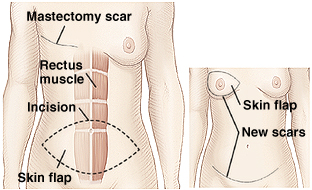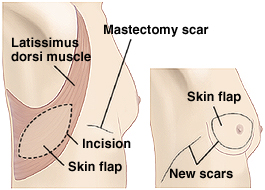Breast Reconstruction with Flap Procedures
A flap procedure uses your own tissue to form the shape of a breast. The 2 most common types of flap procedures are the TRAM flap and the LD flap.
These surgeries are named based on what part of the body the flap tissue is taken from. The surgeries are explained below. Less often, tissue may be moved to the chest from the buttocks or thigh. Flap reconstruction surgeries leave you with 2 surgical wounds: the chest and the site where tissue was removed.
|
Your surgeon can help you decide whether to have reconstructive surgery and what type is best for you. You will be advised to wait if now is not the best time for you. For instance, you may be advised to wait if you need radiation to your chest after surgery.
Talk with your healthcare provider about what the surgery is like and what you can expect after surgery. Also be sure you know what your breast shape will look like and how the donor flap site might be affected.
|
|
 |
| TRAM flap |
|
|
 |
| LD flap |
|
TRAM flap
The TRAM (transverse rectus abdominis myocutaneous) flap uses stomach muscle, fat, and skin. A flap of skin and fat is removed from the lower part of the stomach. Then the flap may be tunneled under the skin from the stomach to the mastectomy site. Or it may be cut free and moved there. The flap is then formed into the shape of a breast. The new breast shape feels soft to the touch. This surgery also makes your belly flatter and tighter, as if you had a "tummy tuck" procedure.
DIEP flap
A DIEP flap is a type of breast reconstruction in which blood vessels called deep inferior epigastric perforators (DIEP), as well as the skin and fat connected to them, are removed from the lower abdomen and transferred to the chest to reconstruct a breast after mastectomy without the sacrifice of any of the abdominal muscles.
The DIEP flap reconstruction procedure is similar to the muscle-sparing free TRAM flap procedure above, but it only requires the removal of skin and fat. Unlike in the TRAM procedure, however, no muscle is sacrificed. The DIEP flap — like the TRAM flap —requires an incision into the abdominal (rectus) muscle, as the blood vessels, or perforators, required to keep the tissue alive lie just beneath or within this muscle. Therefore, a small incision is made in the abdominal muscle in order to access the vessels.
LD flap
The LD (latissimus dorsi) flap uses muscle, fat, and skin from the upper back. The flap of skin and fat is removed from the side of the body, over the ribs. The latissimus dorsi muscle is left attached to the flap. Then the flap is tunneled under the skin to the mastectomy site. There it is formed into the shape of a breast. The new breast feels soft to the touch. In some cases, an implant is needed with this surgery.
Risks of flap reconstruction
Any type of surgery carries some risk. Some problems related to breast reconstruction with a flap can include:
-
Bleeding
-
Fluid collection in either of the surgery areas (called a seroma)
-
Anesthesia problems (problems with the medicines used to do the surgery)
-
Bruising and swelling
-
Implant problems
-
Infection
-
Muscle weakness
-
Scar tissue
-
Increased complications in smokers
-
Problems at the donor site, such as muscle weakness
|
|
Problems are more common in women who smoke. Don't smoke at least 3 to 4 weeks before and 1 to 2 weeks after your procedure. Smoking can interfere with the healing process. Ask your healthcare provider for help quitting.
|